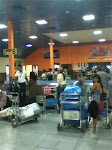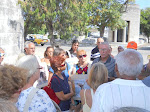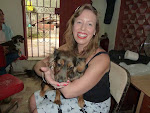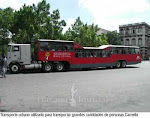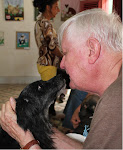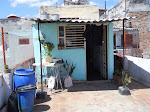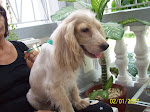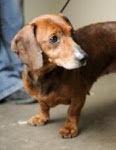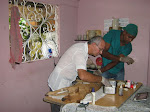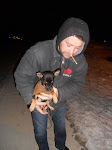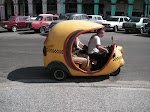A Better Answer
If you're a Canadian, you don't have any tropical vacation spots in your own country--you have to plan international travel to sit on a beach under a palm tree and enjoy the sound of the waves and the feel of the breeze. So you get on a plane, and if you don't want to go further than necessary, you land in Cuba, The Pearl of the Antilles, and the former crown jewel in the Spanish Empire. And the beaches are spectacular, the weather perfect, and the people are friendly. No wonder so many Canadians make the trip. There are no travel restrictions to fight as we have to do here in the US.
Most Canadians love their vacations in Cuba, and few have anything negative to say about their holidays there. One exception we hear is that many deplore the large number of street dogs and strays they see in Cuba. Like other third world places, animals don't get much humane treatment there. But a number of Canadians with kind hearts want to do something about the strays. Often they take pity on the stray and try to arrange its adoption and move back to Canada when they get back home.
Too often we get calls about a dog or a puppy near a resort that is accepting handout food from the tourists and seems to beg to be adopted and taken far away to a new home.
It's hard to counsel people who've allowed some hungry little dog to steal their heart, and who've searched the Internet for someone to help save the unfortunate little animal. But we feel obligated to educate these good-hearted people in the realities of saving the street dogs of Cuba. To arrange a successful adoption and transport takes much more time and money than you might think.
First there's the problem of finding the animal, and then you have to verify that it doesn't have an owner. If this takes place in many parts of Cuba, that might mean a long round trip from Havana for a vet or a volunteer. It could take two trips to find the right dog and bring it to Havana.
Then there's arranging a foster home for at least two weeks, vet exams, deparisitazions, more vet tests, waiting for test results, and arranging air transportation back to Canada. Most of these projects cost more than $500 in expenses before the dog is put on a plane (and this number does not include air transportation charges).
Yes, it might be nice to bring that little lovable animal into your home and to be able to tell your friends of the sad plight he or she faced when found. But for all that time and expense, how much more have you done to reduce animal suffering than if you had visited your local animal shelter and picked out a healthy, life-long friend from a huge range of breeds, sizes, shapes and colors?
No, as much as we all want to help save a hungry street dog from his stark, unhappy street life, we have to realize that isn't always the best answer. We need to stay focused on our main activity, conducting massive spay-neuter campaigns. That, at least, helps street animals by drastically reducing their numbers.
When we discourage these kind souls who want to help, it isn't for lack of compassion--we've got it in spades--it's because we have a better answer. We don't want to seem callous, but we have to focus our energies where we can do the most good for Cuba's animals.
Les Inglis
Friday, May 27, 2011
Sunday, May 22, 2011
Our Cost Rican Connection
Our Costa Rican Connection
You've heard lots in these blogs about Nora Garcia, Aniplant's President. Nora is the central nervous system of animal protection in Cuba. But this time I want to write about another woman who has played an indispensable role in our work in Cuba.
Lilian Schnog is a Dutch woman who comes from Aruba. Years ago she and her husband, Ben, made the move from Aruba to Costa Rica, settling into a beautiful home halfway up a mountain, near the capital, San Jose. Many years ago, I was a Director of HSUS at the time I first heard of Lilian. John Hoyt, HSUS's President and I were talking about the formation of HSI, Humane Society International, when he told me he was making a quick trip to Florida. Lilian had called him and wanted to meet and talk with him about some problems at the WSPA (World Society for Protection of Animals) shelter near her home where she volunteered her time to help the animals.
John met with Lilian and agreed there should be changes at the shelter. Lilian was willing to make a major contribution to acquire the WSPA shelter and animal hospital if she had the support of HSUS, which Hoyt was willing to promise. Her plan was put into effect, and Lilian replaced WSPA's shelter manager and began to run the enterprise, certainly in a more humane fashion.
About that time I made two trips to Costa Rica and was able to see the changes for myself. Lilian was in charge, doing really important work, and HSI had people visiting to advise on improving the animal hospital function. Over the years, HSI and AHPPA, (Asociación Humana Para la Protección de Animales), Lilian's shelter, have maintained their association and in a recent year, Lilian was awarded HSI's highest honor for animal protectors.
When we wanted to supply anesthesia medicines, to Aniplant's spay-neuter campaigns, we needed a source of the meds and a way to get them into Cuba reliably. Lilian did some checking and found out there are no restrictions on trade between Cuba and Costa Rica. She works regularly with a distributor of medicines who exports to Cuba. So our problems were solved. If we could pay for the needed meds, Lilian could buy them and have them shipped to Nora in Cuba. We've done this several times now, and we have a reliable, legal way to ship drugs that Nora cannot otherwise acquire. Also, both Lilian and Nora are certified as persons who can buy, store, and handle controlled substances, which many of the drugs we buy are.
There are many wonderful people who work to help animals. Some are right in our home towns and some are spread out across the globe. We, and the dogs and cats of Cuba, are fortunate to have Lilian Schnog as a friend and a participant in what we are doing in Cuba.
Les Inglis
You've heard lots in these blogs about Nora Garcia, Aniplant's President. Nora is the central nervous system of animal protection in Cuba. But this time I want to write about another woman who has played an indispensable role in our work in Cuba.
Lilian Schnog is a Dutch woman who comes from Aruba. Years ago she and her husband, Ben, made the move from Aruba to Costa Rica, settling into a beautiful home halfway up a mountain, near the capital, San Jose. Many years ago, I was a Director of HSUS at the time I first heard of Lilian. John Hoyt, HSUS's President and I were talking about the formation of HSI, Humane Society International, when he told me he was making a quick trip to Florida. Lilian had called him and wanted to meet and talk with him about some problems at the WSPA (World Society for Protection of Animals) shelter near her home where she volunteered her time to help the animals.
John met with Lilian and agreed there should be changes at the shelter. Lilian was willing to make a major contribution to acquire the WSPA shelter and animal hospital if she had the support of HSUS, which Hoyt was willing to promise. Her plan was put into effect, and Lilian replaced WSPA's shelter manager and began to run the enterprise, certainly in a more humane fashion.
About that time I made two trips to Costa Rica and was able to see the changes for myself. Lilian was in charge, doing really important work, and HSI had people visiting to advise on improving the animal hospital function. Over the years, HSI and AHPPA, (Asociación Humana Para la Protección de Animales), Lilian's shelter, have maintained their association and in a recent year, Lilian was awarded HSI's highest honor for animal protectors.
When we wanted to supply anesthesia medicines, to Aniplant's spay-neuter campaigns, we needed a source of the meds and a way to get them into Cuba reliably. Lilian did some checking and found out there are no restrictions on trade between Cuba and Costa Rica. She works regularly with a distributor of medicines who exports to Cuba. So our problems were solved. If we could pay for the needed meds, Lilian could buy them and have them shipped to Nora in Cuba. We've done this several times now, and we have a reliable, legal way to ship drugs that Nora cannot otherwise acquire. Also, both Lilian and Nora are certified as persons who can buy, store, and handle controlled substances, which many of the drugs we buy are.
There are many wonderful people who work to help animals. Some are right in our home towns and some are spread out across the globe. We, and the dogs and cats of Cuba, are fortunate to have Lilian Schnog as a friend and a participant in what we are doing in Cuba.
Les Inglis
Sunday, May 15, 2011
Doggie Bags
Doggie Bags
Walk around the older parts of Havana and you'll conclude that Cubans spend lots of time sitting on their front stoops. It doesn't matter that the front door is open, as most of these houses don't have air-conditioning. So the door and most of the windows are open, and the owner sits on the step up to the front door with his feet out on the sidewalk.
And the family dog? He's inside unless it's time for him to go out. Then he just lets himself out. The owner doesn't worry about the dog getting lost because he knows the dog will show up at dinner time when his food is set out or even sooner when it's time to get in the shade to avoid the hot sun. So the whole thing about keeping a dog is a pretty casual affair, both on the owner's aprt and on the part of the dog.
Dogs in Cuba almost always get the table scraps from the family's dinner table. You can't buy commercial dog food there unless you're very rich or have CUC's (tourist money) to spend. Neither CUC's nor riches are common in the hands of Cuban people, so table scraps it is for the dog. A few lucky dogs are fed a cooked down mixture of rough rice and slaughterhouse waste (fat, scraps, brains, eyeballs, etc, etc.) That's what the eight dogs who live at Aniplant's headquarters get.
You may already have asked yourself how you can tell if a dog on the street is a family pet or a stray. I'm sorry to say there is no certain test, as Cuban dogs seldom sport collars or ID tags. One not very accurate test is to look at his body. If the ribs are not easy to see, it might be someone's pet, just out for a little pit stop.
No Cuban leaves food on plates in a restaurant, and when I'm there I don't either. You ask for a foam plastic box or perhaps carry a supply of plastic shopping bags like Nora does. Cubans define "doggie bags" better than anywhere else. Here is a country full of animal lovers who share their scant provisions with their animal companions.
When I walk away from a restaurant with a plastic box full of leftovers, I immediately look for a hungry animal, but then I'm faced with the question, which dogs are pets being fed, and which are truly needy street dogs. And one should not make quick decisions in that situation. If I see a dog near a stoop sitter, I ask if that's his dog. I wouldn't want anyone feeding my dogs something, and he probably wouldn't either. I'll offer the owner some of my leftovers if he wants, but I'm really looking for an animal whose ribs are showing. When I find one and no apparent owner is near, there's little difficulty in getting him to eat.
I'm thinking , "Good, now I don't have to carry this box of leftovers around," and the dog is thinking, "Good, now I don't have to be hungry all day."
Les Inglis
Walk around the older parts of Havana and you'll conclude that Cubans spend lots of time sitting on their front stoops. It doesn't matter that the front door is open, as most of these houses don't have air-conditioning. So the door and most of the windows are open, and the owner sits on the step up to the front door with his feet out on the sidewalk.
And the family dog? He's inside unless it's time for him to go out. Then he just lets himself out. The owner doesn't worry about the dog getting lost because he knows the dog will show up at dinner time when his food is set out or even sooner when it's time to get in the shade to avoid the hot sun. So the whole thing about keeping a dog is a pretty casual affair, both on the owner's aprt and on the part of the dog.
Dogs in Cuba almost always get the table scraps from the family's dinner table. You can't buy commercial dog food there unless you're very rich or have CUC's (tourist money) to spend. Neither CUC's nor riches are common in the hands of Cuban people, so table scraps it is for the dog. A few lucky dogs are fed a cooked down mixture of rough rice and slaughterhouse waste (fat, scraps, brains, eyeballs, etc, etc.) That's what the eight dogs who live at Aniplant's headquarters get.
You may already have asked yourself how you can tell if a dog on the street is a family pet or a stray. I'm sorry to say there is no certain test, as Cuban dogs seldom sport collars or ID tags. One not very accurate test is to look at his body. If the ribs are not easy to see, it might be someone's pet, just out for a little pit stop.
No Cuban leaves food on plates in a restaurant, and when I'm there I don't either. You ask for a foam plastic box or perhaps carry a supply of plastic shopping bags like Nora does. Cubans define "doggie bags" better than anywhere else. Here is a country full of animal lovers who share their scant provisions with their animal companions.
When I walk away from a restaurant with a plastic box full of leftovers, I immediately look for a hungry animal, but then I'm faced with the question, which dogs are pets being fed, and which are truly needy street dogs. And one should not make quick decisions in that situation. If I see a dog near a stoop sitter, I ask if that's his dog. I wouldn't want anyone feeding my dogs something, and he probably wouldn't either. I'll offer the owner some of my leftovers if he wants, but I'm really looking for an animal whose ribs are showing. When I find one and no apparent owner is near, there's little difficulty in getting him to eat.
I'm thinking , "Good, now I don't have to carry this box of leftovers around," and the dog is thinking, "Good, now I don't have to be hungry all day."
Les Inglis
Subscribe to:
Posts (Atom)
